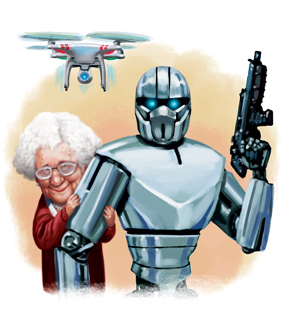
With more senior living facilities focusing on making their environments more homelike, there’s a problem when ubiquitous surveillance cameras, constant security buzzers and flat-screen TV monitors give the décor the look and feel of a prison. To be sure, it’s a delicate balance that facility operators must have in keeping residents safe while giving them a sense of independence and comfort that they’re not being spied upon.
Fortunately, this is an age where technology has advanced to the point where residents can be monitored through unobtrusive means. Wearable sensors, such as pendants, wristwatches and bracelets, allow caregivers to track residents effectively without making them feel like detainees.
“Fundamentally, we believe that if you enter a dementia care area and you notice the emergency call system — whether it’s buzzers and alarm announcements or flashing lights — the system is outdated,” says Sam Youngwirth, principal for CISCOR. “The system should blend into the environment and should not induce stress to the residents.”
With technology’s role in surveillance and protection of residents rapidly expanding over the past decade, systems and platforms have become more integrated, while sensors and software have become more intelligent and accessible, notes James Jansen, Direct Supply product manager of technology solutions.
“As a result, we are able to easily collect and interpret more complex data than ever before,” he says. “This data allows operators to make informed decisions, resulting in improved care outcomes and operational efficiencies. Connected technologies are the platforms that drive increased visibility into community operations, creating more opportunities to engage with residents.”
Mike McLeod, founder and president of Status Solutions, warns facilities about the “dreaded ‘I’ word — institutional” — when it comes to resident monitoring and surveillance.
“Senior living facilities have long had a reputation for being ‘baby hospitals’ and they have to change that perception,” he says. “They have to think of themselves as being a resort. They need to adhere to the basics. Whether standalone or continuum of care, they need to become something that people care about.”
A ‘FITBIT’ WORLD
Wearable technology has come a long way in a short amount of time, with “Fitbit” trackers counting steps, reporting vital signs and reporting biological data to wearers. The capabilities of these units have not only fostered acceptance from users, but unbridled enthusiasm, pointing to a new attitude toward technology’s role in health monitoring, sources say.
Laurence M. Yudkovitch, product manager for RF Technologies’ Senior Living Solutions, says that because wearable technology has gotten smaller, battery life has gotten longer and functionality more capable, devices can be worn 24/7. For instance, the RF Technologies’ Code Alert system includes a wrist-worn radio frequency identification wander tag that has a three year battery life, he says.
“This means we can monitor residents with memory loss and keep them safe in a facility for three years without the need to replace a battery,” Yudkovitch says.
Additionally, new wearable devices are able to capture more data at higher resolutions. Smart watches, for example, can capture heart rate in real time.
“It’s only time before these become mainstream in senior living,” he says.
McLeod calls the awakening to new technology “situational awareness” — society’s adoption of sophisticated technology and social media for communications, information and networking through apps for smartphones, iPads, Fitbits and Apple watches. Facilities can use these tools to create their own version of situational awareness for residents, he says.
“You need to build awareness by starting with competencies — alerting, monitoring and reporting — and build capabilities that give way to creation,” McLeod says. “Use situational awareness to prevent residents from experiencing negative events.”
PREDICTIVE TECHNOLOGY
Today’s monitoring technology is not only designed to be discreet, but to be proactive in protecting residents, Youngwirth says. By gauging resident routines, deviations from that norm signal that a resident may be having trouble and caregivers are alerted to intercede before a potential problem occurs.
The technology isn’t exactly new — CISCOR developed its product line eight years ago and at that time Youngwirth concedes the market wasn’t ready for it.
Over that time span, however, he says the concept has found a growing number of converts in senior living.
“It has become part of the nomenclature now,” he says. “The confidence factor is stronger than ever — not just in healthcare, but in our daily lives. It is part of our work and home environments and the comfort level has reached a point where it is here to stay.”
STRIKING A BALANCE
The most overt signs of resident surveillance are security cameras placed in areas where they draw attention. But how do facility operators compromise on the valuable visual images these cameras provide in order to keep residents from feeling like their privacy is being violated?
Jansen acknowledges that cameras are an important part of any security program, but adds the focus needs to be on “minimizing the security footprint” at the community.
From the December 01, 2015 Issue of McKnight's Senior Living



